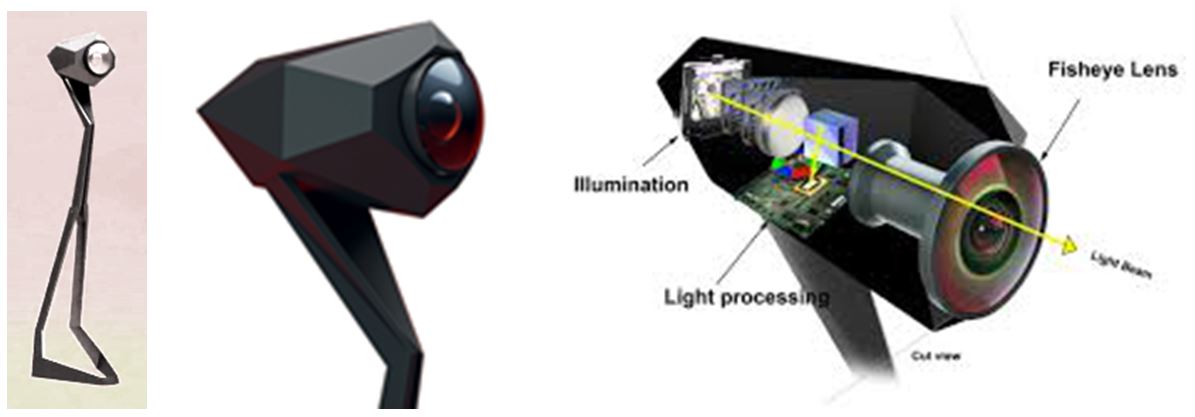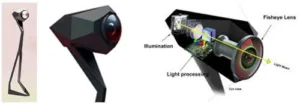Based on technology developed by Catopsys (Paris, France), the Immersis system can project imagery onto the area surrounding a TV. Doing so is intended to enhance the extent of the user’s immersion in a video game or panoramic video. It also allows the user to share the experience with others.

Immersis is not intended to replace the big-screen TV but, rather, augment it. As an example, in a living room setting, the projector could be placed behind and extend above the user’s sofa.

The Immersis system includes 3D scanning capability that effectively maps the room and the objects within it. This allows adaptation of the graphics to the shape and size of the room. The nature of the adaption is such that the imagery “looks right” even when overlaid onto non-flat surfaces, the firm says. A video illustrating the Immersis system can be found at the end of this article.

The main technical difficulty addressed in developing Immersis was calibrating the system. That is, to get the right information displayed at the right place in the projection space and thus recreate the proper perspective from the user’s point of view.
The method developed by the company to accomplish this is described in issued US patent 8272752. The first step in the process is to create a 3D model of the projection space. A configuration tool from Immersis allows the user to either describe the dimensions of the space or to import a 3D model in any one of the standard software formats.
Depending on room dimensions and Immersis’ location, the system will make a calibration file that is used as a basis for the deformation of the image. This deformation is processed in real time by the computer and graphics card controlling Immersis.
Although the deformed image can be created from 360° content, the image is rendered for a 180° projection because the initial version of Immersis was designed with a 180° optical system.
Immersis features and specifications include the following:
- Anamorphic and calibration software
- Native resolution 1920 X 1080
- Field of view: 180° horizontal, 120° vertical
- RGB 3 LED light source 50,000 hours
- Brightness: 3000 Lumens
- 100000:1 contrast
- Weight: 400 oz.
- Video connection: HDMI / DVI
- Dimensions: 70 x 220 x 58 cm
- Compatibility: Windows 8 SP3 and up / Mac OSX 10.6.8 and up
- User can continue to use existing game, TV and other controllers.
It is also possible to integrate a television, monitor or tablets into the imagery projected by the Immersis system. Although not strictly necessary, doing so can be justified in several cases.
- Gamers are used to playing using multiple monitors. Immersis allow them to continue with their custom of focusing on one main screen while allowing them to be immersed in an extended game scene.
- When physical objects are integrated into the projection space.
- To benefit from their higher resolution or for a specific interaction on the screen/touch-screen.
Immersis can project any kind of content at 180° including photographs, videos or video games. All panoramic photo formats are also compatible as is the Google Photosphere format. In addition, Immersis is compatible with any 3D game engine, along with any video format and hardware.
A plug-in has already been developed for Unity 3D. A beta version plug-in for Unreal Engine and a universal plug-in (allowing any video game or 3D application to use Immersis) are also available.
An SDK is available for content providers and developers. All of the Immersis SDKs include access to the Immersis Developer Center. The IDS provides the SDK, technical support and serves as a community for Immersis developers. The SDK will include code, samples and tutorials.
If the concept of the Immersis system sounds just a little bit familiar, there is a reason. In 2012, Microsoft R&D lab developed a project called “Illumiroom”. This system is similar to Immersis in that both try to enhance the gameplay experience. In both cases this is accomplished by filling the player’s peripheral vision with relevant graphics and doing so by use of projection. There are, however, major differences between the two approaches.
The Microsoft approach created multiple peripheral images based on an original “mother” image using image interpolation. The technology developed by Immersis, on the other hand, utilizes panoramic imagery based on multiple parameters (the 3D model of the immersive space, its texture, the user’s point-of-view, the optical system used etc.). Integration of a TV screen is optional in the Immersis system.
The product is reported as in an advanced stage of development. The software is reported as 100% operational. At CES 2015, an Immersis system was shown that had been adapted to work with a 75 cm x 75 cm model.
The company plans to subcontract product manufacturing. The company feels that there is little risk associated with subcontracting in that most of the components are already available on the market. Manufacturing is expected to consist simply of an integration of existing technologies.
To catalyze the Immersis’ program, the company has initiated a Kickstarter campaign. At the time this article is written, 147 backers have pledged $95,662 of a $100,000 goal. The campaign is scheduled to complete on February 17. Assuming that the program is a go, Immersis is aiming to start deliveries in October. The price of the system is expected to be about $2,500. – Arthur Berman
Immersis, +33-09-72318611, [email protected]

